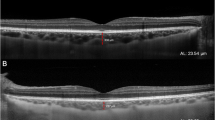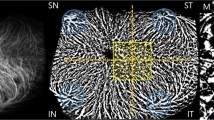Abstract
Background
Idiopathic panuveitis is a diagnosis of exclusion that lacks distinguishing features on fluorescein and indocyanine green angiography. Choroidal hypoperfusion or ischaemia has been implicated in panuveitis of different aetiologies. In this study, we use enhanced depth imaging optical coherence tomography (OCT) to examine the choroid and its vasculature in patients with this disease.
Methods
In this retrospective, cross-sectional study, OCT-derived measurements of retinal and choroidal thickness were obtained after manual segmentation using custom software. Choroidal measurements were further subdivided into Haller’s large vessel layer (HLVL) and Sattler’s medium vessel layer (SMVL), and correlated with clinical parameters.
Results
Twenty-one eyes from 21 patients were included. A reduction in hypo-reflective spaces, corresponding to vascular lumens, was observed in HLVL. The mean thickness of both the choroid (233.7 ± 73.3 μm), and HLVL (167.8 ± 53.7 μm), was less than that previously reported for normal eyes. Choroidal thickness expressed as a ratio to retina thickness showed significant correlation to visual acuity (r = 0.58, p = 0.006). This correlation was maintained in the ratio between HLVL and retinal thickness (r = 0.56, p = 0.009), but not in SMVL to retinal thickness (r = 0.352, p = 0.12).
Conclusions
This study reports novel OCT-derived parameters in patients with idiopathic panuveitis. We noted loss of hyporeflectivity in HLVL, and thinning of both HLVL and the choroid as a whole. The observed correlation between visual acuity and the ratio of choroidal to retinal thickness is a strong enhanced depth imaging (EDI)-OCT derived candidate for prospective validation in future studies.


Similar content being viewed by others
Abbreviations
- RPE:
-
Retinal pigment epithelium
- OCT:
-
Optical coherence tomography
- EDI:
-
Enhanced depth imaging
- FA:
-
Fluorescein angiography
- ICGA:
-
Indocyanine green angiography
- BCVA:
-
Best corrected visual acuity
- logMAR:
-
Logarithm of the minimum angle of resolution
- CMO:
-
Cystoid macular oedema
- ERM:
-
Epiretinal membrane
- HLVL:
-
Haller’s large vessel layer
- SMVL:
-
Sattler’s medium vessel layer
- VKH:
-
Vogt Koyanagi Harada
- MEWDS:
-
Multiple evanescent white dot syndrome
References
Weiner A, BenEzra D (1991) Clinical patterns and associated conditions in chronic uveitis. Am J Ophthalmol 112:151–158
Rothova A, Buitenhuis HJ, Meenken C, Brinkman CJ, Linssen A, Alberts C, Luyendijk L, Kijlstra A (1992) Uveitis and systemic disease. Br J Ophthalmol 76:137–141
Pivetti-Pezzi P, Accorinti M, La Cava M, Colabelli Gisoldi RA, Abdulaziz MA (1996) Endogenous uveitis: an analysis of 1,417 cases. Ophthalmologica 210:234–238
Baarsma GS (1992) The epidemiology and genetics of endogenous uveitis: a review. Curr Eye Res 11(Suppl):1–9
Henderly DE, Genstler AJ, Smith RE, Rao NA (1987) Changing patterns in uveitis. Am J Ophthalmol 103:131–136
Rodriguez A, Calonge M, Pedroza-Seres M, Akova YA, Messmer EM, D’Amico DJ, Foster CS (1996) Referral patterns of uveitis in a tertiary eye care center. Arch Ophthalmol 114:593–599
Spaide RF, Koizumi H, Pozonni MC (2008) Enhanced depth imaging spectral-domain optical coherence tomography. Am J Ophthalmol 146:496–500
Howe L, Stanford M, Graham E, Marshall J (1998) Indocyanine green angiography in inflammatory eye disease. Eye (Lond) 12:761–767
Yuzawa M, Kawamura A, Matsui M (1993) Indocyanine green video-angiographic findings in Harada’s disease. Jpn J Ophthalmol 37:456–466
Oshima Y, Harino S, Hara Y, Tano Y (1996) Indocyanine green angiographic findings in Vogt–Koyanagi–Harada disease. Am J Ophthalmol 122:58–66
Obana A, Kusumi M, Miki T (1996) Indocyanine green angiographic aspects of multiple evanescent white dot syndrome. Retina 16:97–104
Howe LJ, Woon H, Graham EM, Fitzke F, Bhandari A, Marshall J (1995) Choroidal hypoperfusion in acute posterior multifocal placoid pigment epitheliopathy. An indocyanine green angiography study. Ophthalmology 102:790–798
Machida S, Tanaka M, Murai K, Takahashi T, Tazawa Y (2004) Choroidal circulatory disturbance in ocular sarcoidosis without the appearance of retinal lesions or loss of visual function. Jpn J Ophthalmol 48:392–396
Atmaca LS, Sonmez PA (2003) Fluorescein and indocyanine green angiography findings in Behçet’s disease. Br J Ophthalmol 87:1466–1468
Howe LJ, Stanford MR, Graham EM, Marshall J (1997) Choroidal abnormalities in birdshot chorioretinopathy: an indocyanine green angiography study. Eye (Lond) 11:554–559
Vadalà M, Lodato G, Cillino S (2001) Multifocal choroiditis: indocyanine green angiographic features. Ophthalmologica 215:16–21
Sadda SR, Joeres S, Wu Z, Updike P, Romano P, Collins AT, Walsh AC (2007) Error correction and quantitative subanalysis of optical coherence tomography data using computer-assisted grading. Investig Ophthalmol Vis Sci 48:839–848
Joeres S, Tsong JW, Updike PG, Collins AT, Dustin L, Walsh AC, Romano PW, Sadda SR (2007) Reproducibility of quantitative optical coherence tomography subanalysis in neovascular age-related macular degeneration. Investig Ophthalmol Vis Sci 48:4300–4307
Keane PA, Liakopoulos S, Ongchin SC, Heussen FM, Msutta S, Chang KT, Walsh AC, Sadda SR (2008) Quantitative subanalysis of optical coherence tomography after treatment with ranibizumab for neovascular age-related macular degeneration. Investig Ophthalmol Vis Sci 49:3115–3120
Guyer DR, Schachat AP, Green WR (2006) The choroid: structural considerations. In: Ryan SJ (ed) Retina. Elsevier, Philadelphia, pp 33–42
Margolis R, Spaide RF (2009) A pilot study of enhanced depth imaging optical coherence tomography of the choroid in normal eyes. Am J Ophthalmol 147:811–815
Ikuno Y, Maruko I, Yasuno Y, Miura M, Sekiryu T, Nishida K, Iida T (2011) Reproducibility of retinal and choroidal thickness measurements in enhanced depth imaging and high-penetration optical coherence tomography. Investig Ophthalmol Vis Sci 52:5536–5540
Rahman W, Chen FK, Yeoh J, Patel P, Tufail A, Da Cruz L (2011) Repeatability of manual subfoveal choroidal thickness measurements in healthy subjects using the technique of enhanced depth imaging optical coherence tomography. Investig Ophthalmol Vis Sci 52:2267–2271
Yamashita T, Yamashita T, Shirasawa M, Arimura N, Terasaki H, Sakamoto T (2012) Repeatability and reproducibility of subfoveal choroidal thickness in normal eyes of Japanese using different SD-OCT devices. Investig Ophthalmol Vis Sci 53:1102–1107
Ding X, Li J, Zeng J, Ma W, Liu R, Li T, Yu S, Tang S (2011) Choroidal thickness in healthy Chinese subjects. Investig Ophthalmol Vis Sci 52:9555–9560
Fujiwara A, Shiragami C, Shirakata Y, Manabe S, Izumibata S, Shiraga F (2012) Enhanced depth imaging spectral-domain optical coherence tomography of subfoveal choroidal thickness in normal Japanese eyes. Jpn J Ophthalmol 56:230–235
Nandakumar N, Branchini L, Regatieri CV (2011) Characterization of choroidal morphology in healthy eyes using spectral domain optical coherence tomography. Investig Ophthalmol Vis Sci 52:E-Abstract 285
Maruko I, Iida T, Sugano Y, Oyamada H, Sekiryu T, Fujiwara T, Spaide RF (2011) Subfoveal choroidal thickness after treatment of Vogt–Koyanagi–Harada disease. Retina 31:510–517
Fong AH, Li KK, Wong D (2011) Choroidal evaluation using enhanced depth imaging spectral-domain optical coherence tomography in Vogt–Koyanagi–Harada disease. Retina 31:502–509
Aoyagi R, Hayashi T, Masai A, Mitooka K, Gekka T, Kozaki K, Tsuneoka H (2012) Subfoveal choroidal thickness in multiple evanescent white dot syndrome. Clin Exp Optom 95:212–217
Yasuno Y, Okamoto F, Kawana K, Yatagai T, Oshika T (2009) Investigation of multifocal choroiditis with panuveitis by three-dimensional high-penetration optical coherence tomography. J Biophotonics 2:435–441
Iaccarino G, Cennamo G, Forte R, Cennamo G (2009) Evaluation of posterior pole with echography and optical coherence tomography in patients with Behçet’s disease. Ophthalmologica 223:250–255
Disclosure
Dr Sim receives funding from Fight For Sight UK, Grant 1987.
Drs. Keane, Patel, Sim, Lee, Tufail and Pavesio receive financial support from the Department of Health’s NIHR Biomedical Research Centre for Ophthalmology at Moorfields Eye Hospital and UCL Institute of Ophthalmology. The views expressed in the publication are those of the authors and not necessarily those of the Department of Health.
Dr Zarranz-Ventura is a grant recipient of the Spanish Retina & Vitreous Society (Sociedad Española de Retina y Vítreo, SERV).
The authors have full control of all primary data and they agree to allow Graefe’s Archive for Clinical and Experimental Ophthalmology to review the data if requested.
Author information
Authors and Affiliations
Corresponding author
Rights and permissions
About this article
Cite this article
Karampelas, M., Sim, D.A., Keane, P.A. et al. Choroidal assessment in idiopathic panuveitis using optical coherence tomography. Graefes Arch Clin Exp Ophthalmol 251, 2029–2036 (2013). https://doi.org/10.1007/s00417-013-2330-7
Received:
Revised:
Accepted:
Published:
Issue Date:
DOI: https://doi.org/10.1007/s00417-013-2330-7




